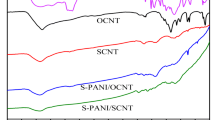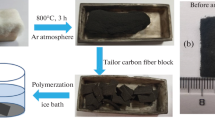Abstract
The self-sustaining hybrid electrode was prepared via chemical polymerization of aniline in acid medium containing dispersed carbon nanotubes (CNT), using carbon fiber (CF) as conducting substrate. The ternary composites called PAni/CNT/CF were characterized in order to evaluate their morphologies, structures, and thermal properties. The influence of the polyaniline (PAni) layer in the ternary composite properties was studied considering different deposition times on CF samples (30, 60, and 90 min). The ternary composite morphologies were observed by scanning electron microscopy while thermal structural analyses were obtained using thermogravimetric measurements. The structural features were analyzed by Raman scattering spectroscopy and Fourier transform infrared spectroscopy (FTIR). The possible interactions between PAni and CNT were discussed on the basis of Raman and FTIR spectra. These spectroscopic analyses also confirmed that the PAni present in the composite is in the emeraldine (ES) salt form. Furthermore, the ternary composites were also evaluated by electrochemical measurements such as cyclic voltammetry (CV), galvanostatic charge–discharge, and electrochemical impedance spectroscopy (EIS) techniques. The results showed good charge storage capacity for ternary composites, in particular, for PAni/CNT/CF obtained with 90 min of deposition time, which exhibited specific capacitance of around 500 F g−1. Therefore, this electrode was selected to build a prototype of type I supercapacitor. This device presented specific capacitance of around 143 F g−1 after 3200 charge/discharge cycles.









Similar content being viewed by others
References
Ates M (2013) A review study of (bio)sensor systems based on conducting polymers. Mater Sci Eng C 33:1853–1859
Saraswathi R, Gerard M, Malhotra BD (1999) Characteristics of aqueous polycarbazole batteries. J Appl Polym Sci 74:145–150
Kawai T, Kuwabara T, Wang S, Yoshino K (1990) Secondary battery characteristics of poly (3-alkylthiophene ). Jpn J Appl Physic 29:602–605
Snook GA, Kao P, Best AS (2011) Conducting-polymer-based supercapacitor devices and electrodes. J Power Sources 196:1–12
Burke A (2000) Ultracapacitors: why, how, and where is the technology. J Power Sources 91:37–50
Ryu KS, Kim KM, Park YJ, Park NG, Kang MG, Chang SH (2002) Redox supercapacitor using polyaniline doped with Li salt as electrode. Solid State Ionics 152–153:861–866
Noh KA, Kim DW, Jin CS, Shin KH, Kim JH, Ko JM (2003) Synthesis and pseudo-capacitance of chemically-prepared polypyrrole powder. J Power Sources 124:593–595
Sivakkumar SR, Kim WJ, Choi JA, MacFarlane DR, Forsyth M, Kim DW (2007) Electrochemical performance of polyaniline nanofibres and polyaniline/multi-walled carbon nanotube composite as an electrode material for aqueous redox supercapacitors. J Power Sources 171:1062–1068
Stejskal J, Sapurina I, Trchová M (2010) Polyaniline nanostructures and the role of aniline oligomers in their formation. Prog Polym Sci (Oxford) 35:1420–1481. doi:10.1016/j.progpolymsci.2010.07.006
Li H, Wang J, Chu Q, Wang Z, Zhang F, Wang S (2009) Theoretical and experimental specific capacitance of polyaniline in sulfuric acid. J Power Sources 190:578–586
Mi H, Zhang X, An S, Ye X, Yang S (2007) Microwave-assisted synthesis and electrochemical capacitance of polyaniline/multi-wall carbon nanotubes composite. Electrochem Commun 9:2859–2862
Canobre SC, Almeida DAL, Polo Fonseca C, Neves S (2009) Synthesis and characterization of hybrid composites based on carbon nanotubes. Electrochim Acta 54:6383–6388
Horng YY, Lu YC, Hsu YK, Chen CC, Chen LC, Chen KH (2010) Flexible supercapacitor based on polyaniline nanowires/carbon cloth with both high gravimetric and area-normalized capacitance. J Power Sources 195:4418–4422
Zhang K, Zhang LL, Zhao XS, Wu J (2010) Graphene/polyaniline nanofiber composites as supercapacitor electrodes. Chem Mater 22:1392–1401
Lin YR, Teng H (2003) A novel method for carbon modification with minute polyaniline deposition to enhance the capacitance of porous carbon electrodes. Carbon 41:2865–2871
Bleda-Martínez MJ, Morallón E, Cazorla-Amorós D (2007) Polyaniline/porous carbon electrodes by chemical polymerisation: effect of carbon surface chemistry. Electrochim Acta 52:4962–4968
Kim C, Choi YO, Lee WJ, Yang KS (2004) Supercapacitor performances of activated carbon fiber webs prepared by electrospinning of PMDA-ODA poly(amic acid) solutions. Electrochim Acta 50:883–887
Staiti P, Lufrano F (2010) Investigation of polymer electrolyte hybrid supercapacitor based on manganese oxide-carbon electrodes. Electrochim Acta 55:7436–7442
Xia K, Gao Q, Jiang J, Hu J (2008) Hierarchical porous carbons with controlled micropores and mesopores for supercapacitor electrode materials. Carbon 46:1718–1726
Tian Y, Song Y, Tang Z, Guo Q, Liu L (2008) Influence of high temperature treatment of porous carbon on the electrochemical performance in supercapacitor. J Power Sources 184:675–681
Zhang H, Cao G, Wang W, Yuan K, Xu B, Zhang W, Cheng J, Yang Y (2009) Influence of microstructure on the capacitive performance of polyaniline/carbon nanotube array composite electrodes. Electrochim Acta 54:1153–1159
Hao M, Chen Y, Xiong W, Zhang L, Wu L, Fu Y, Mei T, Wang J, Li J, Wang X (2016) Electrochimica Acta coherent polyaniline/ngraphene oxides/multi-walled carbon nanotubes ternary composites for asymmetric supercapacitors. Electrochim Acta 191:165–172
Shulga YM, Baskakov SA, Abalyaeva VV, Efimova ON, Shulga NY, Michtchenko A, Lartundo-Rojas L, Moreno-R LA, Cabañas-Moreno JG, Vasilets VN (2013) Composite material for supercapacitors formed by polymerization of aniline in the presence of graphene oxide nanosheets. J Power Sources 224:195–201
Morávková Z, Trchová M, Tomšík E, Cechvala J, Stejskal J (2012) Enhanced thermal stability of multi-walled carbon nanotubes after coating with polyaniline salt. Polym Degrad Stab 97:1405–1414
Thakur AK, Deshmukh AB, Choudhary RB, Karbhal I, Majumder M, Shelke MV (2017) Facile synthesis and electrochemical evaluation of PANI/CNT/MoS 2 ternary composite as an electrode material for high performance supercapacitor. Mater Sci Eng B 223:24–34
Aymen M, Sami S, Ahmed S, Gmati F, Mohamed AB (2013) Correlation between Raman spectroscopy and electrical conductivity of graphite/polyaniline composites reacted with hydrogen peroxide. J Phys D Appl Phys 46:335103
Louarn G, Lapkowski M, Quillard S, Pron A, Buisson JP, Lefrant S (1996) Vibrational properties of polyaniline—isotope effects. J Phys Chem 100:6998–7006
Mažeikienė R, Statino A, Kuodis Z, Niaura G, Malinauskas A (2006) In situ Raman spectroelectrochemical study of self-doped polyaniline degradation kinetics. Electrochem Commun 8:1082–1086
Pereira Da Silva JE, Córdoba De Torresi SI, De Faria DLA, Temperini MLA (1999) Raman characterization of polyaniline induced conformational changes. Synth Met 101:834–835
CochetM, Louarn G, Quillard S, BoyerMI, Buisson JP, Lefrantet S (2000) Theoretical and experimental vibrational study of polyaniline in base forms: non-planar analysis. I J Raman Spectrosc 31:1029–1039
Wei Z, Wan M, Lin T, Dai L (2003) Polyaniline nanotubes doped with sulfonated carbon nanotubes made via a self-assembly process. Adv Mater 15:136–139
Boyer M-I, Quillard S, Rebourt E, Louarn G, Buisson JP, Monkman A, Lefrant S (1998) Vibrational analysis of polyaniline: a model compound approach. J Phys Chem B 102:7382–7392
Lapkowski M, Berrada K, Quillard S, Louarn G, Lefrant S, Pron A (1995) Electrochemical oxidation of polyaniline in nonaqueous electrolytes: “in situ” Raman spectroscopic studies. Macromolecules 28:1233–1238
Da Silva JEP, De Torresi SIC, Temperini MLA (2000) Redox behavior of crosslinked polyaniline films. J Braz Chem Soc 11:91–94
Trchová M, Morávková Z, Bláha M, Stejskal J (2014) Raman spectroscopy of polyaniline and oligoaniline thin films. Electrochim Acta 122:28–38
do Nascimento GM, Kobata PYG, Millen RP, Temperini MLA (2007) Raman dispersion in polyaniline base forms. Synth Met 157:247–251
Devendrappa H, Rao UVS, Prasad MVNA (2006) Study of dc conductivity and battery application of polyethylene oxide/polyaniline and its composites. J Power Sources 155:368–374
Bao S, Du M, Zhang M, Zhu H, Wang P, Yang T, Zou M (2014) Facile fabrication of polyaniline nanotubes/gold hybrid nanostructures as substrate materials for biosensors. Chem Eng J 258:281–289
David T, Mathad JK, Padmavathi T, Vanaja A (2014) Part-a: synthesis of polyaniline and carboxylic acid functionalized SWCNT composites for electromagnetic interference shielding coatings. Polymer (U K) 55:5665–5672
Bavio MA, Acosta GG, Kessler T (2014) Synthesis and characterization of polyaniline and polyaniline—carbon nanotubes nanostructures for electrochemical supercapacitors. J Power Sources 245:475–481
Potphode DD, Sivaraman P, Mishra SP, Patri M (2015) Polyaniline/partially exfoliated multi-walled carbon nanotubes based nanocomposites for supercapacitors. Electrochim Acta 155:402–410
Malik R, Zhang L, Mcconnell C, Schott M, Hsieh YY, Noga R, Alvarez NT, Shanov V (2017) Composite-based electrode for high-performance supercapacitors. Carbon 116:579–590
Fonseca CP, Almeida DAL, Oliveira MCD, Baldan MR, Ferreira NG (2015) Influence of the polymeric coating thickness on the electrochemical performance of carbon fiber/PAni composites. Polímeros 25:425–432
Kobayashi T, Yoneyama H, Tamura H (1984) Oxidative degradation pathway of polyaniline film electrodes. J Eletroctroanal Chem 177:293–297
Genies EM, Tsintavis C (1985) Redox mechanism and electrochemical behayiour of polyaniline deposits. J Eletroctroanal Chem 195:109–128
Kitani A, Kaya M, Yano J, Yoshikawa K, Sasaki K (1987) Polyaniline: formation reaction and structure. Synth Met 18:341–346
Zhang H, Cao G, Wang Z, Yang Y, Shi Z, Gu Z (2008) Tube-covering-tube nanostructured polyaniline/carbon nanotube array composite electrode with high capacitance and superior rate performance as well as good cycling stability. Electrochem Commun 10:1056–1059
Ning G, Li T, Yan J, Xu C, Wei T, Fan Z (2013) Three-dimensional hybrid materials of fish scale-like polyaniline nanosheet arrays on graphene oxide and carbon nanotube for high-performance ultracapacitors. Carbon 54:241–248
Arulmani S, Wu JJ, Anandan S (2017) Amphiphilic triblock copolymer guided polyaniline embraced CNT nanohybrid with outcropping whiskers as an energy storage electrode. Electrochim Acta 246:737–747
Lei W, He P, Zhang S, Dong F, Ma Y (2014) One-step triple-phase interfacial synthesis of polyaniline-coated polypyrrole composite and its application as electrode materials for supercapacitors. J Power Sources 266:347–352
Acknowledgements
The authors thank to Dr. Jose Augusto Jorge Rodrigues and Pedro Henrique Lopes Nunes Abreu dos Santos by Thermogravimetric Analyses. This work was supported by the CNPq proc. number 150663/2010-2, FAPESP proc. number 2009/17584-0, and CAPES.
Author information
Authors and Affiliations
Corresponding author
Rights and permissions
About this article
Cite this article
Almeida, D.A.L., Edwards, E.R. & Ferreira, N.G. Self-sustaining hybrid electrode prepared from polyaniline, carbon nanotubes, and carbon fibers: morphological, structural, and electrochemical analyses. J Solid State Electrochem 22, 69–80 (2018). https://doi.org/10.1007/s10008-017-3722-0
Received:
Revised:
Accepted:
Published:
Issue Date:
DOI: https://doi.org/10.1007/s10008-017-3722-0




